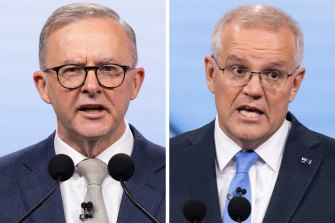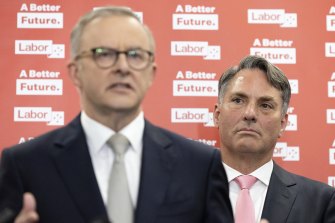Why women should vote for the Coalition

While we might not know who will be Prime Minister next week, one thing we can be sure of is professional women will have played a large role in getting him there.
You might not know it from the attention both sides lavish on the nation’s 1.5 million male tradies, but their numbers are dwarfed by professional females who at almost 2 million are now the single largest occupation group in Australia.
Opposition Leader Anthony Albanese and Prime Minister Scott Morrison.Credit:Alex Ellinghausen
Labor’s attempt to appeal to this group has primarily involved attacking the character of Scott Morrison. Fairly or unfairly, the strategy has worked, with successive polls showing female voters have drifted from him to give Albanese a solid lead as preferred PM.
Albanese frequently appears with his female frontbenchers. Yet watching them together will have brought back memories of the worst days in the office for many professional women.
In week one, when Albanese couldn’t name either the unemployment or cash rate, he swiftly put his ALP finance spokeswoman Katy Gallagher in the hot seat before the press. She correctly answered both.
Albanese reassured us in future he would “fess up” when mistakes were made and fix them.
Yet only days later he told reporters Labor’s GP clinics policy had been fully costed by the Parliamentary Budget Office. It had not. It was left to Gallagher to explain that one too.
It doesn’t take a focus group of female professionals to tell you the one thing they hate is a boss too lazy to get across the detail who then leaves them to clean up his messes.
And it’s not just Albanese that reminds female professionals of what poor leadership looks like.
When the late senator Kimberley Kitching raised the conduct of her ALP Senate colleagues toward her with Richard Marles, he did nothing, later hiding behind the feeble excuse that she hadn’t made an official bullying complaint.
Opposition Leader Anthony Albanese and his deputy Richard Marles.Credit:Alex Ellinghausen
Marles admits Kitching told him how unhappy she was at being kicked off the Labor’s Senate tactics committee despite being a star parliamentary performer. But although he was deputy opposition leader and the most senior parliamentary member of Kitching’s faction, he put it in the too-hard basket, leaving Kitching isolated in her workplace.
Luckily for the Coalition, although Albanese is out-polling Morrison as preferred PM, with a week to go almost a third of female voters are yet to make up their mind on who they think should have the top job.
But can the Coalition show women how life for them has improved under its government?
While it is well known the unemployment rate is 4 per cent, the story is even better for female unemployment which at only 3.7 per cent is the lowest it’s been since 1974.
This will have changed the lives of thousands of Australian women. The Coalition should be telling these stories to personalise the statistics.
At the ALP campaign launch, Albanese promised to tackle the gender pay gap. The Coalition doesn’t need to enter a policy bidding war on this, it should just tell voters what’s happened while it’s been in government.
Because the gap has narrowed substantially: it’s now 13.8 per cent compared to 17.4 per cent when Labor left office.
But then anyone who is truly concerned about gender pay equity must surely be scratching their heads to work out why Anthony Albanese is paid over $100,000 more than Katy Gallagher given recent events.
Why hasn’t the Coalition been able to capture more of the female vote? The reasons are complex but one is surely that it hasn’t made clear how day-to-day life has improved for them and their families.
One example is the Pharmaceutical Benefits Scheme. The last budget saw the life-saving drug Zolgensma being listed on it. At a whopping $2.5 million for a one-off treatment it’s the most expensive drug ever listed on the PBS. Its listing is expected to save the lives of 30 children who suffer from spinal muscular atrophy every year. It’s hard to imagine a mother who doesn’t think that’s a good thing.
Another drug listed, Trodelvy, treats rare breast cancer. It costs up to $80,000 per treatment. Previously women who couldn’t afford it were denied the chance of a longer life and more time with their families.
Over the last nine years more than 2900 new or amended listings on the PBS were approved.
Why does it matter? Because, otherwise, Australians who couldn’t afford those drugs, including life-saving medications, couldn’t access them.
Could that really happen in egalitarian Australia? It did. In 2011, the Gillard government stopped listing medicines on the PBS including medicines for chronic pain, IVF and endometriosis.
That would be the same government that kicked tens of thousands of single mothers off parenting payments and onto the unemployment benefit, Newstart, leaving many between $60 and $100 a week worse off. The legislation passed the Senate on the same day Gillard was lecturing the Coalition about misogyny.
Perhaps something for uncommitted female voters to ponder.
Cut through the noise of the federal election campaign with news, views and expert analysis from Jacqueline Maley. Sign up to our Australia Votes 2022 newsletter here.
Most Viewed in National
From our partners
Source: Read Full Article


